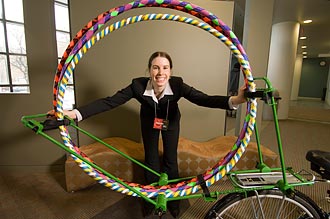Engineering senior turns her hobby into cash
It started off pretty simply. Danielle McIntosh, a University of Wisconsin–Madison senior graduating in biological systems engineering, was intrigued by a friend who brought his hula hoop over to her apartment. She and her roommates would try out practicing with the hoop, and she found herself thinking about it even when her friend wasn’t around.

UW-Madison senior Danielle McIntosh poses with a Hoopla Rack, an invention of hers that earned her $5,700 in prize money at the College of Engineering’s Innovation Days this spring. The rack is designed to make the transport of hula hoops easier.
Photo: David
Nevala
“I was sitting at work one day, and I was thinking back to that time, and I’m like, I think I can make a hula hoop,” she says. “I looked up on the Internet how to do it, and it was really easy, and I was just hooked after that.”
At first she was only making and decorating hula hoops for herself, including a collapsible one that she took with her to Australia in the fall of 2006 while she studied abroad. After she returned, though, she finished designing her Web site and soon had a thriving hula-hoop making business.
“I was amazed when I got my first order. To be honest, I didn’t know if anyone would want to buy them. I never did any advertising that first year, and when I got the e-mail I was very excited, and she was ordering a really cool design, so I was so thrilled to have my hula hoop be sent – little did I know how many would come.”
After selling more than 50 hula hoops that first year to people from all over the country, Danielle took a break from making hula hoops to focus on schoolwork. Focusing on schoolwork, however, didn’t mean a break from hula hoops – in fact, McIntosh spent the fall of 2007 creating a hula-hoop rack for her bicycle, a project that took up more than 20 hours per week as part of her capstone senior design class for biological systems engineering.
The idea for a hula-hoop rack came from her own experiences trying to transport the hoops, which at an average size of 42 inches are much larger than the child-sized hula hoops most people are familiar with and are often weighted with sand or water to increase the difficulty in hooping with them. While her car worked fine for carrying them, McIntosh wanted an environmentally friendly way to transport them to places like the Union Terrace and the post office for shipping.
Her advisor, biological systems engineering professor David Bohnhoff, says the hula-hoop rack is atypical for design projects in the department, which frequently focus on areas like natural resource conservation, but that the spirit of the projects fits in very well with biological systems engineering, which he calls the “sustainable engineering” department on campus. He adds that it’s unusual for students to take on a design project on their own, but that he let Danielle branch off because of her obvious dedication to the project.
“Always when someone has their heart in another spot, you know, just doing this for awhile, I know I’ve just got to let them follow their heart. It’s important to them, and you can see it come out in the final product, as well,” he says.
Bohnhoff also made sure that even though she was working on the project independently, she was not alone in it. He met with her weekly to brainstorm ideas and helped her with some of the more technical elements of construction, such as welding.
“We’ve found that it’s very important to give students that hands-on construction experience and the reason for that is they just become much better designers,” he says. “When they clearly understand how it goes together and how it’s made, they’re able to really reduce costs and make things more efficient.”
While some students have construction experience, he adds that many get help along the way in building the project. The main goal of the class is learning how the design process works and using their analysis skills from engineering classes to improve the design.
“Part of this is saying, ‘Hey, come on now. Apply your skills and optimize this design that you’ve just created,’” he says. “If you don’t do that, what you’re doing is not any different than somebody who’s working on something in the garage after work. What are you bringing to the table?”
The hula-hoop rack has, so far, been a major success. McIntosh won $5,700 in prize money at the College of Engineering’s Innovation Days this spring, including a 3rd place prize in the Schoofs Prize for Creativity competition, 3rd place prize in the Tong Prototype Prize competition, and the Younkle Best Presentation Award. The rack, which McIntosh calls the Hoopla rack, uses four knobs to raise and lower the low-carbon steel bars that hold the hula hoops in place, and it is painted John Deere green as an homage to other students in her field collaborating with that manufacturer.
McIntosh has not yet decided whether she’ll market the hula-hoop rack, which has a manufacturing cost of $160 and is higher than her original goal of $100, but she is currently seeking a patent for the design. She has also been making and designing her own hula hoops, unlike her first sales, which were designed to customers’ specifications, and is considering selling them again. In the meantime, she is teaching hula-hooping courses that focus on core-building and learning tricks with the hoop at Main Street Yoga in Madison.
Jim Manos, owner of Main Street Yoga, says he was excited to add hula-hooping classes back into his studio after his former instructor left. In addition to yoga and hula hooping, the studio also offers contact improvisational dance courses and Nia, a combination of dance and martial arts.
"I wanted to have my studio be something different than just a yoga studio – I thought that was just a little too restrictive for offering something to the community, so I wanted to have it be primarily a yoga studio, but also a movement center, as well, so that different styles of movement could be experienced or practiced there,” he says. McIntosh currently teaches the classes on Saturday mornings from 12:30 p.m. to 1:30 p.m. The classes cost $5 in cash and alternate between core and tricks weeks. She recommends beginners come to a core class first to learn the basics of hooping.
After graduating in May, McIntosh will pursue environmental consulting in engineering, and plans to travel to Rwanda in August with Engineers Without Borders. The organization received a grant to bring hula hoops there to celebrate World Hoop Day on Aug. 8, and will also begin assessments of a village’s water supply, McIntosh says.
Even after the summer, one thing that is for certain is that she will continue to pursue hula hooping.
“That’s something that I think is going to be with me for the rest of my life,” she says. “It’s really cool the kinds of people that you meet and the experience that you get to share together as you’re all practicing this sport with an unusually large hula hoop. You look at particular little group of people and you can find a hula hooper among them.”
Tags: business, entrepreneurship, learning


